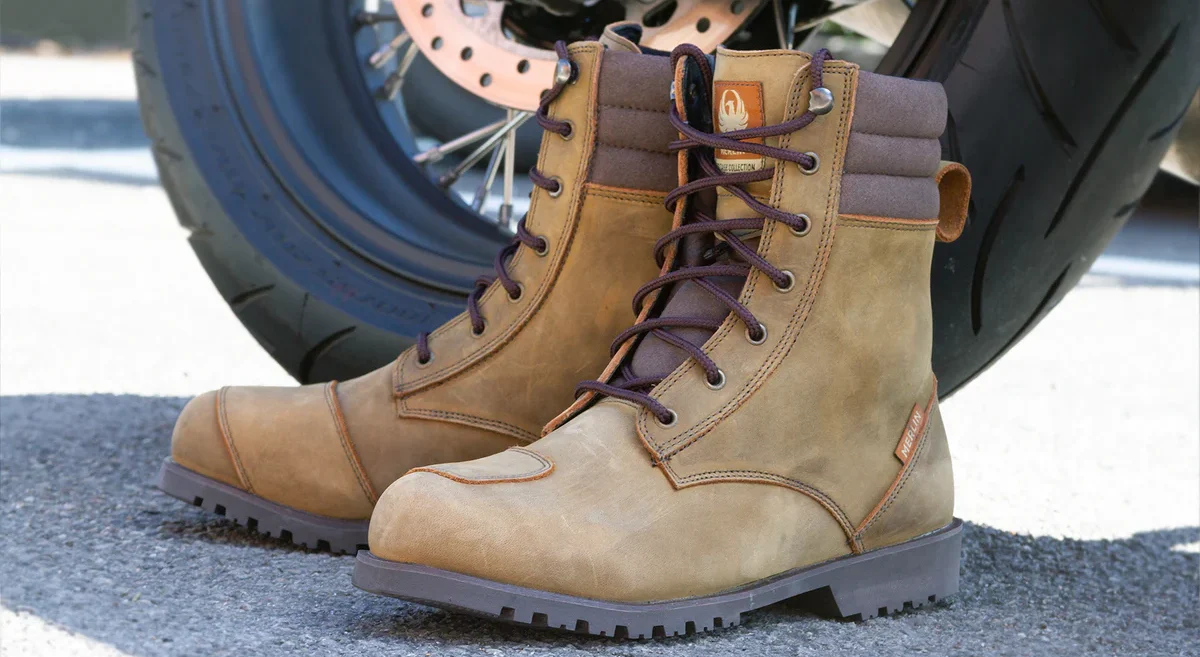The Ultimate Guide to Motorcycle BOOTS

The Ultimate Guide to Motorcycle BOOTS

But why are motorcycle boots so essential? What makes them different from regular boots? And how do you find the right pair that fits you and your riding style?
We’ve been reviewing motorcycle parts and gear for over a decade. So if you needed help making an informed buying decision, you came to the right place.
Keep reading for more tips on how to pick the perfect pair of motorcycle boots.
Why you need a High Quality Pair Of Motorcycle Boots

Much like motorcycle gloves for your hands, a high quality pair of motorcycle boots for your feet are an oft-overlooked piece of moto-gear. But the fact is that after helmets and gloves, motorcycle boots are one of the most important things you need to get.
In the event of a crash, your feet are some of the most vulnerable parts of your body. They can very easily bind with the pavement, resulting in abrasive injuries, fractures to the foot and ankle, and other such injuries.
Additionally, there is the risk of your motorcycle falling and your feet getting caught under it. Most crashes that involve the bike falling on top of your feet result in fractures to the ankle, the foot, and even the lower leg.
In fact, some reports say that as much as 82% of all injuries caused by motorcycle crashes were to the lower half of the body!
This is where motorcycle boots come in. They are specifically designed to protect your feet from abrasion and impact in the event of a crash. To protect against abrasion, motorcycle boots use materials like leather, synthetic materials, or a combination of the two that offers high abrasion-resistance.
If you crash and slide on the pavement, the abrasions can cause skin to bruise or get punctured. In extreme cases, you could even experience a degloving injury, wherein entire layers of the skin are peeled away.
Punctured skin can even get infected by contaminants from the road surface, which can result in various diseases and illnesses.
The motorcycle boot may also offer impact protection that can prevent bruises and even fractures to your feet and legs. The impact protection may be in the form of protective inserts in the boot that absorb some of the impact.
Your ankles are especially susceptible to damage in the event of a motorcycle crash, which is why many boots cover the ankle and part of the lower leg.
Motorcycle boots should be worn no matter what type of riding you do, but the need for these boots becomes even more pressing if you ride your bike off-road. Here, you will have to deal with a lot more unexpected obstacles which could cause even more damage if you crash.
Motorcycle boots also add as much as 2 or 3 inches to your height, which can help you flat-foot the bike more easily off-road. Being able to get both feet flat on the ground can be one of the most confidence-inspiring things for offroading.
The Different Types Of Motorcycle Boots

There are different motorcycle boots for different motorcycles, riding styles, and use cases. Which type you choose will depend on your particular needs, where you usually ride your motorcycle, and any specific features you want.
Touring Boots
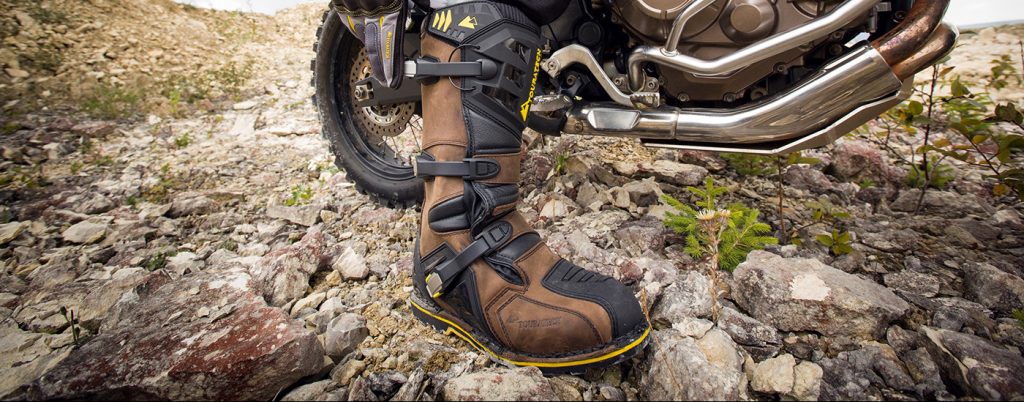
Touring motorcycle boots are most often used by tourers and adventure riders who are looking to soak up highway miles in comfort and safety.
These boots usually come up a bit higher than your ankle and are made of leather. That said, they tend to lag behind other boots in terms of sturdiness.
The fit of these boots is meant to be comfortable so that you don’t get sore feet a couple thousand miles from home. They offer protective inserts for the shin and ankle areas, which are the most susceptible to injury in the event of a crash.
Touring boots will also usually be waterproof, keeping your feet dry if it starts pouring.
They may be called touring boots, but they can be used by pretty much any rider for any type of riding. This is because they provide a good balance of protection, comfort, and style.
Securing boot to foot is usually handled by Velcro and/or zip mechanisms for more ease of use.
Sports Boots
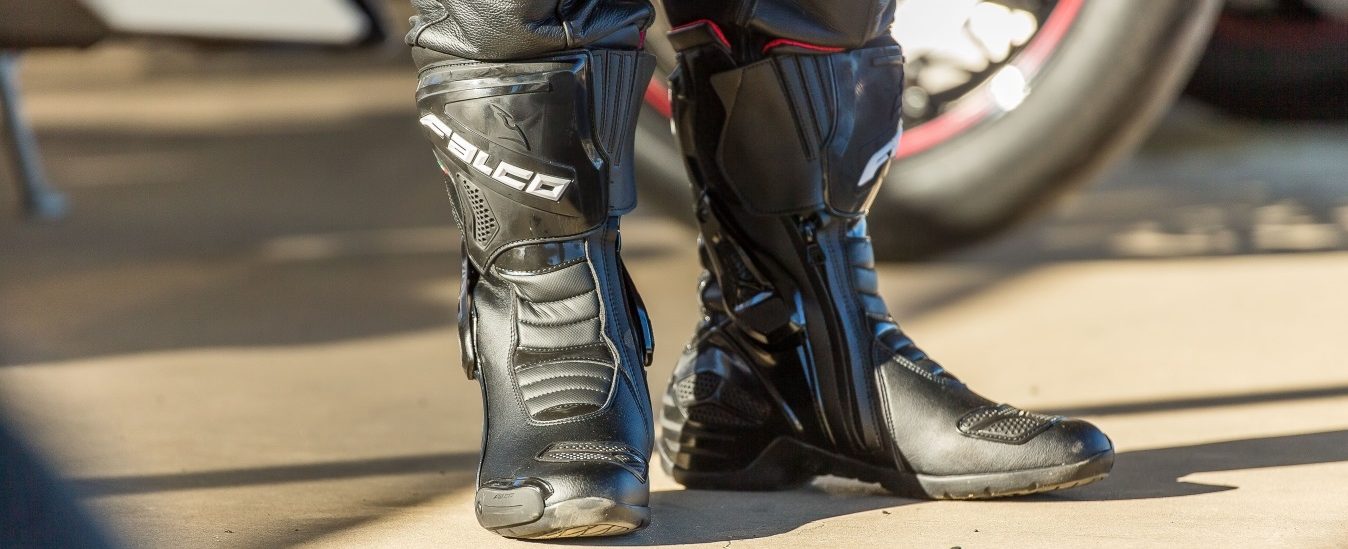
Sports motorcycle boots are almost the exact opposite of touring boots. Where touring boots are suitable for just about any type of rider and riding style, sports motorcycle boots are pretty much only usable on the track.
If you ride your sportbike or other two-wheeler on the track, you’ll need all the protection you can get to avoid injury in case of a high-speed crash.
So sports motorcycle boots offer the most protection of any boot out there. They come up higher past your ankle, even covering a lot of the lower leg.
They are usually made of tough leather or a micro-fiber material called Lorica. This material offers higher abrasion-resistance than leather, while also featuring better breathability. It is a lightweight alternative to leather, which is great for the track, where you need to save every ounce of weight from your bike and your person.
Another cool feature a lot of sports motorcycle boots offer is flame-resistant layers on top of the boot. This is to prevent any flammable liquids or fuel from catching fire when you’re on the track.
As for the closure mechanism, we often see buckles, or even ratchet systems that are easy to operate when you’re fully kitted out in your riding leathers.
However, because they need to offer so much protection in a lightweight package, these boots tend to be a bit on the tight and uncomfortable side.
They don’t offer the most mobility either, save for essential stuff like shifting gears and applying the rear brake. In fact, most sports motorcycle boots will become uncomfortable for anything longer than a couple hours, making them unsuitable for more frequent riding.
Still, if you want the most protective motorcycle boot, there is no substitute.
Cruiser/Biker Boots
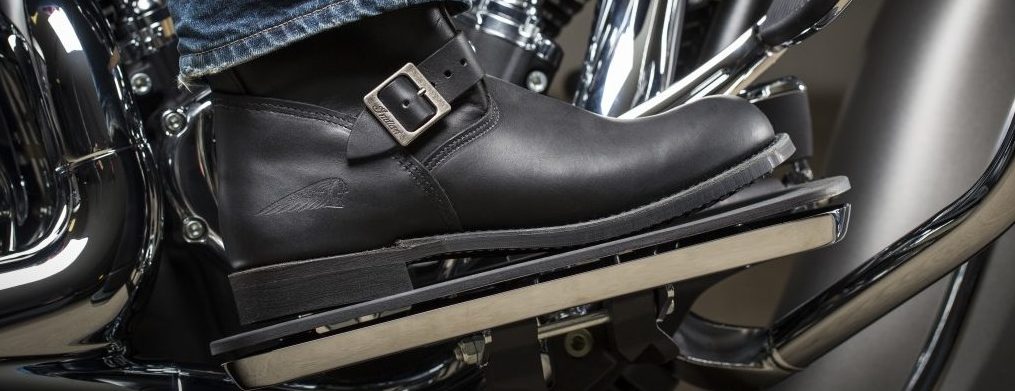
Biker boots are the most common style of motorcycle boot. These boots are designed to look similar to the normal boots that you might wear already. They offer the most comfortable, loose fit for daily riding.
Biker boots are usually worn by motorcyclists trying to split the difference between riding gear and their normal attire. Most of the boot will be made of leather, but with fabric or synthetic material mixed in for breathability and comfort.
They are shorter than other types of motorcycle boots, often only coming up to your ankle. Higher styles are rare, and even then, they don’t offer the most impact protection.
The most you can expect is some extra ankle protection, in addition to a higher heel that allows for better grip and stability.
Interestingly, these boots may be made of even thicker leather than the other types of boots we’ve discussed. This means you still get a lot of abrasion-resistance for street-riding.
The obvious drawbacks include less impact protection, and exposed shins and calves. You do get enhanced comfort and mobility in exchange, which might be more to your liking.
Off-Road Boots
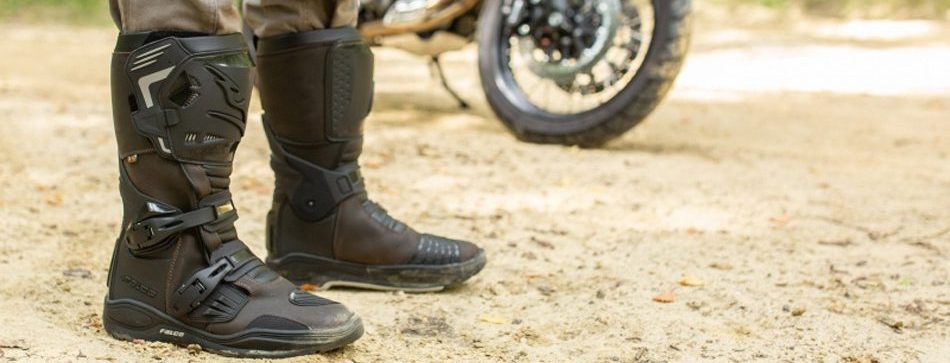
Off road boots are the large, highly-protective boots you will have seen professional motocross riders and off-road motorcyclists wearing. They are designed to be used in the most demanding off-road conditions, so you get extra protection inserts.
Off-road motorcycle boots come up to the knee, and the whole boot is usually reinforced with high quality plastic or even carbon material. This improves both abrasion-resistance and impact-absorption.
These types of boots are made of leather but offer the highest quality and sturdiness of any motorcycle boot. They give you enhanced protection for the ankle, the calves, and the shins.
The soles are also designed with off-roading in mind. Many dirt bikers will plant one of their feet for added stability and control while off-roading or maneuvering the bike, so the soles are designed to enhance grip on gravel, uneven surfaces, and the like.
These tend to be the most uncomfortable motorcycle boots of all. They aren’t suitable for long journeys, or daily commuting. And while they provide just as much, if not more protection than sports motorcycle boots, the limited mobility and larger size will hinder on-track performance.
What To Look For When Buying Motorcycle Boots

What type of motorcycle boot you buy will depend on your exact use case and requirements. But when buying any motorcycle boot, it is important to keep a couple key features in mind.
Materials
The material a motorcycle boot is made of is one of the most important considerations to make when buying. The type and quality of the materials will determine how much abrasion-resistance the boot has.
We recommend getting motorcycle boots made of high quality leather, as it offers the best abrasion-resistance. Still, high quality leather tends to be heavier and more expensive.
It also doesn’t offer the best breathability, which might be a concern for you. Fabric and synthetic materials might give you a lighter, more breathable alternative, but the tradeoff is abrasion resistance and sturdiness.
Impact Protection
In an ideal world, you would have ALL the impact protection in your motorcycle boot.
But in a world where more impact protection means heavier, more expensive, and less comfortable boots, how much impact protection your motorcycle boot should have will depend on what kind of riding you do, and the type of motorcycle you ride.
Generally speaking, the motorcycle boot you buy should have at least some impact protection, regardless of the type of riding you do.
If your motorcycle riding mostly consists of the daily commute and around-town riding, you don’t necessarily need to have the largest boot or the most impact protection.
But switch to heavy off-road riding and you will need more protection for your shins, ankles, and calves. Similarly, if you like to go 200 mph on the track, you will need more impact protection than regular biker boots can offer.
Fit
You might want to get a motorcycle boot that is comfortable and loose-fitting. But the truth is that you might be better off getting a boot that is tighter and almost uncomfortably so.
This is because the tighter fit allows the boot to stay securely on your foot in the event of a crash. If you have the stomach for it, look up some motorcycle crash videos. Notice how often the riders’ shoes go flying in the event of a crash.
All the impact protection and abrasion-resistance in the world is useless if the boot can’t even stay on your foot. So if you regularly take your bike to the track, where the risk of high speed crashes is higher, a tighter-fitting boot is what you need.
That said, you don’t want your motorcycle boot to be excessively uncomfortable if you like riding for longer stretches. So if you ride a touring bike across continents, you should get a boot with a slightly looser fit but one that still has the necessary safety features you need.
Design
We saved ‘design’ for last, since the design of a motorcycle boot should be the last thing you consider when buying.
You should make sure that the boot you choose has enough impact protection and abrasion-resistance for your needs, it fits according to the demands of your use case, and that it is made of high quality materials for added durability and sturdiness.
Once all of that is sorted, you can consider the design and aesthetics of the boot.
How Much Should You Spend On A Pair Of Motorcycle Boots?

And now the million dollar ques…
No, no, no, wait! Come back! Motorcycle boots don’t cost a million dollars!!!
That said, they aren’t exactly cheap either. But when you consider the special materials, the reinforced design, and the high-tech impact protection inserts, It’s easy to see why high quality motorcycle boots cost so much.
Still, you don’t have to pay…an arm and a leg…for a pair of motorcycle boots. At the same time, we would warn against the extremely budget-friendly options out there. You don’t want to find out where those corners were cut.
As a rule of thumb, we would recommend buying a pair of motorcycle boots in the $200-$400 range. Any less, and you risk getting sub-par materials and less effective impact protection. Any higher, and you might be paying for the brand or some special features that you probably don’t need.
